Don's Maps
Resources for the study of Palaeolithic / Paleolithic European, Russian, Ukrainian and Australian Archaeology / Archeology
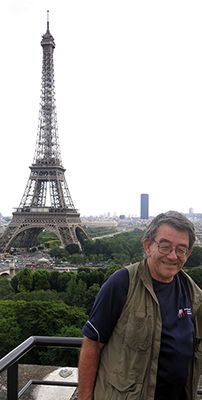
Photo: Me in Paris, on top of the Musée de l'Homme.
 This sitemap link provides access to all the pages on my site.
This sitemap link provides access to all the pages on my site.
Most searches for subjects covered in Don's Maps can be accomplished by searching on this page for the subject you are after, using your browser's search bar.
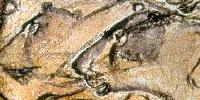
Index of caves and rock shelters with wall paintings and engravings
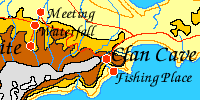 Maps of the Earth's Children Series including a map of Journeys in the Land of Painted Caves, the last book in the series.
Maps of the Earth's Children Series including a map of Journeys in the Land of Painted Caves, the last book in the series.
Maps include the true extent of the ice in the last ice age, as well as maps of The Territory of the Zelandonii, Journeys in Clan of the Cave Bear, local area around the cave in Clan of the Cave Bear, The Valley of Horses, Iron Gates map, local map of the Sharamudoi, local map of The Mammoth Hunters Lion Camp, map of Ukraine, map of The Plains of Passage, Clickable map of the Plains of Passage, Donau Mouth to First Snow from the Plains of Passage, The Encounter with the S'Armunai, Wurm and Riss Glaciation in the headwaters of the Donau (Danube), How I draw the maps.
Recent updates
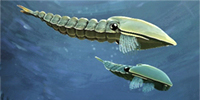 A selection of the animals and plants from the Precambrian to the Cretaceous. The page includes maps of the continents of the earth as they travelled back and forth across the globe.
A selection of the animals and plants from the Precambrian to the Cretaceous. The page includes maps of the continents of the earth as they travelled back and forth across the globe.
Last updated Sunday 30 November 2025
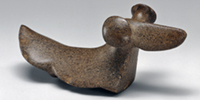 Birdstones are small, abstract stone carvings that resemble a bird and are thought to have been used as a weight for an atlatl. They are generally three to four inches long and less than two inches tall. They are found at archaic sites in midwestern and eastern North America, including the Great Lakes region and east of the Mississippi River. The majority are made from banded slate, particularly the greenish-grey Huronian variety, but other stones like porphyry have also been used.
Birdstones are small, abstract stone carvings that resemble a bird and are thought to have been used as a weight for an atlatl. They are generally three to four inches long and less than two inches tall. They are found at archaic sites in midwestern and eastern North America, including the Great Lakes region and east of the Mississippi River. The majority are made from banded slate, particularly the greenish-grey Huronian variety, but other stones like porphyry have also been used.
Last updated Saturday 21 December 2024
 Accessing the collection of rock art photographs by Heinrich Wendel, who documented many of the rock art sites in the Franco-Cantabrian region between 1964 and 1970 - the Neanderthal Museum has kindly made available to the general public the collection of superb photographs from the Wendel Collection. This page will show you how to access the page and to download any files you wish to use.
Accessing the collection of rock art photographs by Heinrich Wendel, who documented many of the rock art sites in the Franco-Cantabrian region between 1964 and 1970 - the Neanderthal Museum has kindly made available to the general public the collection of superb photographs from the Wendel Collection. This page will show you how to access the page and to download any files you wish to use.
Last updated Thursday 12 December 2024
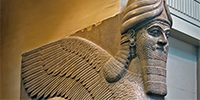 The Neo-Assyrian Empire was a powerful state that existed in the ancient Near East from 911 BC to 609 BC. It was the largest empire in the world at the time and covered much of modern-day Iraq, Syria, and parts of Iran, Turkey, and Egypt. The Neo-Assyrians were known for their military might, efficient administration, and innovative use of technology, including the development of siege warfare and the use of iron weapons. They also had a well-organised system of government, with a king who had absolute power and a bureaucracy that helped him govern.
Last updated Monday 09 September 2024
The Neo-Assyrian Empire was a powerful state that existed in the ancient Near East from 911 BC to 609 BC. It was the largest empire in the world at the time and covered much of modern-day Iraq, Syria, and parts of Iran, Turkey, and Egypt. The Neo-Assyrians were known for their military might, efficient administration, and innovative use of technology, including the development of siege warfare and the use of iron weapons. They also had a well-organised system of government, with a king who had absolute power and a bureaucracy that helped him govern.
Last updated Monday 09 September 2024
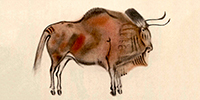 Dots and lines are the most ubiquitous abstract symbols in Palaeolithic art, whether on the walls of caves or on suitable pieces of bone and ivory. Many researchers have noted the occurrence of these symbols, and their occurrence particularly in relation to representations of animals. Here I have put together some of the best examples. The evidence presented here shows that where the evidence exists and the data is sufficient, there is no correlation between the Taxon and the number of dots or lines. For example, horses have numbers of dots and lines which are spread across the range of 1, 2, 3, 4, 5, 6, and 7, and Aurochs (early cattle) have numbers of dots and lines which include 1, 3, 4, 5, 6, 18, and many.
Dots and lines are the most ubiquitous abstract symbols in Palaeolithic art, whether on the walls of caves or on suitable pieces of bone and ivory. Many researchers have noted the occurrence of these symbols, and their occurrence particularly in relation to representations of animals. Here I have put together some of the best examples. The evidence presented here shows that where the evidence exists and the data is sufficient, there is no correlation between the Taxon and the number of dots or lines. For example, horses have numbers of dots and lines which are spread across the range of 1, 2, 3, 4, 5, 6, and 7, and Aurochs (early cattle) have numbers of dots and lines which include 1, 3, 4, 5, 6, 18, and many.
Last updated Monday 16 January 2023
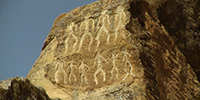 Gobustan on the Caspian Sea is a site dated to around 5 000 - 8 000 years BP, where there are paintings or etchings (petroglyphs) of what appear to be long boats in the style of the Viking ships of more recent times, as well as many other types, including human outlines, horses, and aurochs. More photographs and text have been added.
Gobustan on the Caspian Sea is a site dated to around 5 000 - 8 000 years BP, where there are paintings or etchings (petroglyphs) of what appear to be long boats in the style of the Viking ships of more recent times, as well as many other types, including human outlines, horses, and aurochs. More photographs and text have been added.
Last updated Sunday 14 May 2023
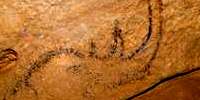 The oldest cave paintings in Central Europe, estimated at between 23 000 and 35 000 BP, were discovered by a team of Romanian speleologists at the Coliboaia Cave, Romania. More photographs and text have been added.
The oldest cave paintings in Central Europe, estimated at between 23 000 and 35 000 BP, were discovered by a team of Romanian speleologists at the Coliboaia Cave, Romania. More photographs and text have been added.
Last updated Saturday 04 February 2023
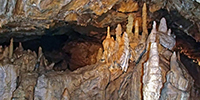 The Mladečské Caves are a cave complex in the municipality of Mladeč in the Czech Republic, about 80 km north east of Brno. The site is a valuable resource for artefacts from the Old and Middle Palaeolithic.
The Mladečské Caves are a cave complex in the municipality of Mladeč in the Czech Republic, about 80 km north east of Brno. The site is a valuable resource for artefacts from the Old and Middle Palaeolithic.
Last updated Tuesday 21 May 2024
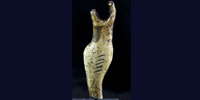 El Pendo Cave, Camargo, province of Santander, is famous for the venus figure found there. More photographs of the cave, the artwork on the walls, and portable art found there have been added.
El Pendo Cave, Camargo, province of Santander, is famous for the venus figure found there. More photographs of the cave, the artwork on the walls, and portable art found there have been added.
Last updated Wednesday 15 November 2023
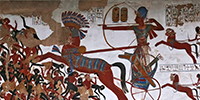 Ancient Egyptian culture from its beginnings through the dynasties to the Ptolemaic period and its eventual decline as a Roman Province, told through reference to its mummies, statues, burial practices and artefacts.
Although my first love is the stone age, mostly before 10 000 BP, I have also become interested in the magnificent works of art produced in ancient Egypt. This set of pages is being constantly updated.
Ancient Egyptian culture from its beginnings through the dynasties to the Ptolemaic period and its eventual decline as a Roman Province, told through reference to its mummies, statues, burial practices and artefacts.
Although my first love is the stone age, mostly before 10 000 BP, I have also become interested in the magnificent works of art produced in ancient Egypt. This set of pages is being constantly updated.
Last updated Wednesday 11 September 2024
 The Gudenushöhle cave is situated 20 km northwest of the city of Krems, in the valley of the Little Krems, not far from Willendorf, in Lower Austria. The site is close to the River Danube, and has yielded both Neanderthal and Magdalenian artefacts, including many tools, as well as an engraved reindeer bone and a fragment of a bone flute dated to about 18 000 – 12 000 BP.
The Gudenushöhle cave is situated 20 km northwest of the city of Krems, in the valley of the Little Krems, not far from Willendorf, in Lower Austria. The site is close to the River Danube, and has yielded both Neanderthal and Magdalenian artefacts, including many tools, as well as an engraved reindeer bone and a fragment of a bone flute dated to about 18 000 – 12 000 BP.
Last updated Sunday 25 December 2022
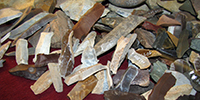 During the Upper Palaeolithic, ice age hunters used the slopes of the Danube valley repeatedly. Willendorf is one such site, and although justly famous for the Venus of Willendorf, it is also an important Gravettian and Aurignacian site for the other artefacts found there.
During the Upper Palaeolithic, ice age hunters used the slopes of the Danube valley repeatedly. Willendorf is one such site, and although justly famous for the Venus of Willendorf, it is also an important Gravettian and Aurignacian site for the other artefacts found there.
Last updated Monday 26 December 2022
 The small cave of Les Eyzies or la Grotte Richard opens above the village of Les Eyzies-de-Tayac, on the right shore of the Beune. Its prehistoric occupation is established in the Upper Magdalenian. It has been largely forgotten, but is an important site.
The small cave of Les Eyzies or la Grotte Richard opens above the village of Les Eyzies-de-Tayac, on the right shore of the Beune. Its prehistoric occupation is established in the Upper Magdalenian. It has been largely forgotten, but is an important site.
Last updated Tuesday 20 December 2022
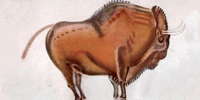 Altamira Cave is 270 metres long and consists of a series of twisting passages and chambers, and is decorated with ice age paintings. The artists used charcoal and ochre or haematite to create the images. They also exploited the natural contours in the cave walls to give their subjects a three-dimensional effect. The Polychrome Ceiling is the most impressive feature of the cave, depicting a herd of extinct Steppe Bison in different poses, two horses, a large doe, and possibly a wild boar. Around 13 000 years ago a rockfall sealed the cave's entrance, preserving its contents until its eventual discovery.
Altamira Cave is 270 metres long and consists of a series of twisting passages and chambers, and is decorated with ice age paintings. The artists used charcoal and ochre or haematite to create the images. They also exploited the natural contours in the cave walls to give their subjects a three-dimensional effect. The Polychrome Ceiling is the most impressive feature of the cave, depicting a herd of extinct Steppe Bison in different poses, two horses, a large doe, and possibly a wild boar. Around 13 000 years ago a rockfall sealed the cave's entrance, preserving its contents until its eventual discovery.
Last updated Saturday 28 September 2024
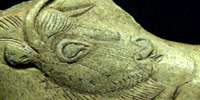 La Madeleine is a rock shelter located in the Vézère valley, in the Dordogne, France. In 1926 the skeleton of a three year old child was discovered, with exquisite shell jewellery, dating from the end of the Magdalenian period. It is a treasure house of art and knowledge about the people of the Magdalenian. Several historic photographs, as well as modern ones of the gisement have been added, as well as much more information on the tools.
La Madeleine is a rock shelter located in the Vézère valley, in the Dordogne, France. In 1926 the skeleton of a three year old child was discovered, with exquisite shell jewellery, dating from the end of the Magdalenian period. It is a treasure house of art and knowledge about the people of the Magdalenian. Several historic photographs, as well as modern ones of the gisement have been added, as well as much more information on the tools.
Last updated Thursday 12 December 2024
 Photoshop for beginners - I am not an expert, I am a beginner myself (though I have spent many years trying to understand a small part of this encyclopaedia for image manipulation), but this text and images may be of use to someone just starting out on the Photoshop journey. At the moment it covers part of rotation and cropping and healing of images, removing backgrounds, and healing just the edge of an object. I will be adding to this initial study as time affords.
Photoshop for beginners - I am not an expert, I am a beginner myself (though I have spent many years trying to understand a small part of this encyclopaedia for image manipulation), but this text and images may be of use to someone just starting out on the Photoshop journey. At the moment it covers part of rotation and cropping and healing of images, removing backgrounds, and healing just the edge of an object. I will be adding to this initial study as time affords.
Last updated Thursday 30 January 2025
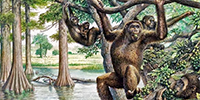 The swamp ape Oreopithecus bambolii was 120 cm tall and weighed 30 kg, with a brain capacity of up to 200 cm3 lived in swampy areas of what is now Italy, 10 to 8 million years ago. The long forelimbs are indicative of tree-dwelling. The ape went extinct after a land bridge connected their island to the mainland, allowing large saber-toothed cats and other predators to stalk the island.
The swamp ape Oreopithecus bambolii was 120 cm tall and weighed 30 kg, with a brain capacity of up to 200 cm3 lived in swampy areas of what is now Italy, 10 to 8 million years ago. The long forelimbs are indicative of tree-dwelling. The ape went extinct after a land bridge connected their island to the mainland, allowing large saber-toothed cats and other predators to stalk the island.
Last updated Saturday 04 June 2022
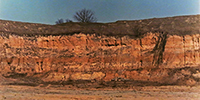 Achenheim is an important site from the Middle Palaeolithic (75 000 to 35 000 years ago) and bears witness to the presence of Neanderthal man in Alsace: Achenheim was an animal butchering area. The site includes the bones of several large animals (rhinoceros, horse, mammoth, bison, Megaloceros) butchered on the spot after the hunt.
Achenheim is an important site from the Middle Palaeolithic (75 000 to 35 000 years ago) and bears witness to the presence of Neanderthal man in Alsace: Achenheim was an animal butchering area. The site includes the bones of several large animals (rhinoceros, horse, mammoth, bison, Megaloceros) butchered on the spot after the hunt.
Last updated Wednesday 11 May 2022
 Magical amber animals - many of the Mesolithic period’s artistic masterpieces have been found in Denmark. Among them are bears, a bird and an elk of amber. The figures are elegant and shaped in a way that is true to nature. The people who made them must have had a good knowledge of how a real bear, and other animals, looked. Like many other amber finds from the Stone Age, the animal figures have been found in bogs or on beaches. Many appear to be amulets, and probably had great spiritual significance.
Magical amber animals - many of the Mesolithic period’s artistic masterpieces have been found in Denmark. Among them are bears, a bird and an elk of amber. The figures are elegant and shaped in a way that is true to nature. The people who made them must have had a good knowledge of how a real bear, and other animals, looked. Like many other amber finds from the Stone Age, the animal figures have been found in bogs or on beaches. Many appear to be amulets, and probably had great spiritual significance.
Last updated Saturday 27 April 2024
 Lalinde/Gonnersdorf figurines and engravings are strictly stylised, overtly female forms with over-sized buttocks, long trunks, small or missing breasts, and no heads. More information and images as well as plans and cross sections of the Gare de Couze and the Grotte de la Roche near the town of Lalinde have been added.
Lalinde/Gonnersdorf figurines and engravings are strictly stylised, overtly female forms with over-sized buttocks, long trunks, small or missing breasts, and no heads. More information and images as well as plans and cross sections of the Gare de Couze and the Grotte de la Roche near the town of Lalinde have been added.
Last updated Saturday 21 October 2023
 The Venus of Willendorf is made of a rock called oolite, a form of limestone that is not found in or around Willendorf. Gerhard Weber and his team from the University of Vienna have now found out with the help of high-resolution tomographic images that the material from which the Venus was carved likely comes from northern Italy, at Lake Garda, about 700 km away.
The Venus of Willendorf is made of a rock called oolite, a form of limestone that is not found in or around Willendorf. Gerhard Weber and his team from the University of Vienna have now found out with the help of high-resolution tomographic images that the material from which the Venus was carved likely comes from northern Italy, at Lake Garda, about 700 km away.
Last updated Monday 26 December 2022
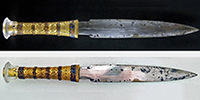 Iron smelting was unknown in Egypt 3 400 years ago, yet a dagger from the tomb of Pharaoh Tutankhamun has been positively identified as having an iron blade made from metal extracted from a meteorite. It may have been a gift from Tušratta, king of Mitanni to Pharaoh Amenhotep III, who passed it on to his son, Akhenaten, who in turn passed it on to Tutankhamun.
Iron smelting was unknown in Egypt 3 400 years ago, yet a dagger from the tomb of Pharaoh Tutankhamun has been positively identified as having an iron blade made from metal extracted from a meteorite. It may have been a gift from Tušratta, king of Mitanni to Pharaoh Amenhotep III, who passed it on to his son, Akhenaten, who in turn passed it on to Tutankhamun.
Last updated Sunday 06 March 2022
 Micoque tools - La Micoque is a Neanderthal site in the Dordogne dating from circa 400 000 BP to 130 000 BP. A number of tools have been added to the page.
Micoque tools - La Micoque is a Neanderthal site in the Dordogne dating from circa 400 000 BP to 130 000 BP. A number of tools have been added to the page.
Last updated Friday 25 February 2022
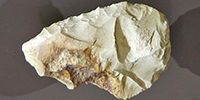 Le Moustier is the type site for the Mousterian suite of tools and artefacts, and is a Neanderthal site. It is of interest primarily to those specialising in le Moustier and the lithic industry of the Mousterian. Several tools from Le Moustier have been added to this page.
Le Moustier is the type site for the Mousterian suite of tools and artefacts, and is a Neanderthal site. It is of interest primarily to those specialising in le Moustier and the lithic industry of the Mousterian. Several tools from Le Moustier have been added to this page.
Last updated Thursday 14 December 2023
 La Quina is a Neanderthal site located in the Charente region of south-western France. The artisans of the La Quina Mousterian industry type (thick asymmetric tools transformed many times) had a particular way of life: they were hunters specialising in the hunt for Reindeer or Bison, and they moved following the herds. Several tools from La Quina have been added to this page.
La Quina is a Neanderthal site located in the Charente region of south-western France. The artisans of the La Quina Mousterian industry type (thick asymmetric tools transformed many times) had a particular way of life: they were hunters specialising in the hunt for Reindeer or Bison, and they moved following the herds. Several tools from La Quina have been added to this page.
Last updated Thursday 11 August 2022
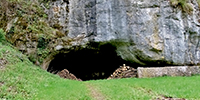 Fontalès is a rock shelter and prehistoric site of the Magdalenian, which is in the commune of Saint-Antonin-Noble-Val , in Tarn-et-Garonne. It was excavated in 1865 by Victor Brun, then from 1936 to 1960 by Paul Darasse. The site has yielded a stratigraphic sequence comprising several levels of occupation dating from the Upper Magdalenian.
Fontalès is a rock shelter and prehistoric site of the Magdalenian, which is in the commune of Saint-Antonin-Noble-Val , in Tarn-et-Garonne. It was excavated in 1865 by Victor Brun, then from 1936 to 1960 by Paul Darasse. The site has yielded a stratigraphic sequence comprising several levels of occupation dating from the Upper Magdalenian.
Last updated Saturday 19 February 2022
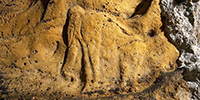 La Grande Grotte de Saint-Front is a little over a kilometre upstream from Domme, on the left bank of the Dordogne. Also known as La Grotte du Mammouth, it contains a number of engravings and sculptures, including a superb Mammoth on a high ceiling.
La Grande Grotte de Saint-Front is a little over a kilometre upstream from Domme, on the left bank of the Dordogne. Also known as La Grotte du Mammouth, it contains a number of engravings and sculptures, including a superb Mammoth on a high ceiling.
Last updated Sunday 13 August 2023
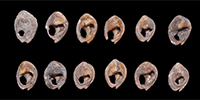 In Morocco, archaeologists have discovered what they claim to be the oldest jewellery ever found in the world. They are perforated shells that are up to 150 000 years old. The shells, which were believed to have been made into necklaces and bracelets, were found in the Bizmoune Cave near the coastal town of Essaouira.
In Morocco, archaeologists have discovered what they claim to be the oldest jewellery ever found in the world. They are perforated shells that are up to 150 000 years old. The shells, which were believed to have been made into necklaces and bracelets, were found in the Bizmoune Cave near the coastal town of Essaouira.
Last updated Tuesday 23 November 2021
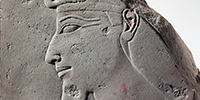 An account of the Battle of Megiddo (fought in the 15th century BC) between Egyptian forces under the command of Pharaoh Thutmose III and a large rebellious coalition of Canaanite vassal states led by the king of Kadesh. It is the first battle to have been recorded in what is accepted as relatively reliable detail.
An account of the Battle of Megiddo (fought in the 15th century BC) between Egyptian forces under the command of Pharaoh Thutmose III and a large rebellious coalition of Canaanite vassal states led by the king of Kadesh. It is the first battle to have been recorded in what is accepted as relatively reliable detail.
Last updated Thursday 12 September 2024
 Ancient Egyptian culture from its beginnings through the dynasties to the Ptolemaic period and its eventual decline as a Roman Province, told through reference to its mummies, statues, burial practices and artefacts.
Although my first love is the stone age, mostly before 10 000 BP, I have also become interested in the magnificent works of art produced in ancient Egypt. This set of pages is being constantly updated.
Ancient Egyptian culture from its beginnings through the dynasties to the Ptolemaic period and its eventual decline as a Roman Province, told through reference to its mummies, statues, burial practices and artefacts.
Although my first love is the stone age, mostly before 10 000 BP, I have also become interested in the magnificent works of art produced in ancient Egypt. This set of pages is being constantly updated.
Last updated Wednesday 11 September 2024
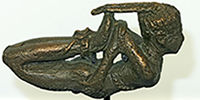
Nubia and the Kingdom of Kush covered an area larger than that of Egypt, and as old, stretching from the 1st cataract of the Nile to the junction of the Blue and White Nile at Khartoum. At one time, during the 25th Dynasty, all of Egypt and Nubia was ruled by the Nubians, who invaded Egypt and attempted to bring it back to its former glory, with all of its ancient Egyptian art and gods. This page traces the history of Nubia from its earliest known beginnings with a Palaeolithic handaxe found at Selima Oasis in Sudan, made around 100 000 BC, to the end of the Meroitic Culture in 350 AD, when Meroë was destroyed by the Ethiopian Kingdom of Aksum.
Last updated Monday 06 May 2024
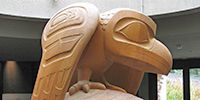 In the Pacific Northwest Coast mythology, Raven is the powerful figure who transforms the world. Stories tell how Raven created the land, released the people from a cockle shell, and brought them fire. Raven stole the light and brought it out to light up the world. Yet Raven is a trickster—often selfish, hungry, and mischievous. He changes the world only by cleverly deceiving others in his never - ending quest for food.
In the Pacific Northwest Coast mythology, Raven is the powerful figure who transforms the world. Stories tell how Raven created the land, released the people from a cockle shell, and brought them fire. Raven stole the light and brought it out to light up the world. Yet Raven is a trickster—often selfish, hungry, and mischievous. He changes the world only by cleverly deceiving others in his never - ending quest for food.
Last updated Tuesday 14 September 2021
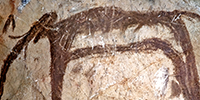 In 1940 at Baume-Latrone, or Latrone Cave, drawings from the Upper Palaeolithic were discovered in a deep network 240 metres from the entrance.
They have a unique style, and have been assigned to the Aurignacian. They have been dated to 37 464 BP (cal).
In 1940 at Baume-Latrone, or Latrone Cave, drawings from the Upper Palaeolithic were discovered in a deep network 240 metres from the entrance.
They have a unique style, and have been assigned to the Aurignacian. They have been dated to 37 464 BP (cal).
Last updated Monday 02 December 2024
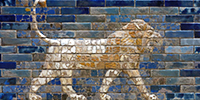 The Ishtar Gate was the eighth gate to the inner city of Babylon. It was constructed in about 575 BC by order of King Nebuchadnezzar II on the north side of the city. It was part of a grand walled processional way leading into the city. The walls were finished in glazed bricks mostly in blue, with animals and 'dragons' in low relief at intervals, these also made up of bricks that are moulded and coloured differently.
The Ishtar Gate was the eighth gate to the inner city of Babylon. It was constructed in about 575 BC by order of King Nebuchadnezzar II on the north side of the city. It was part of a grand walled processional way leading into the city. The walls were finished in glazed bricks mostly in blue, with animals and 'dragons' in low relief at intervals, these also made up of bricks that are moulded and coloured differently.
Last updated Thursday 20 April 2023
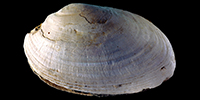 On the banks of the Bengawan Solo River in Java, Indonesia, 19th-century physician Eugène Dubois uncovered an astounding fossil find: the bones of what appeared to be an ancient human, surrounded by animal remains and shells. Excavated in the 1890s, the site gained fame as the home of 'Java Man', better known today as Homo erectus. Deliberate scratching on a fossil Pseudodon shell, is almost certainly an engraving made by Homo erectus at Trinil in Indonesia.
On the banks of the Bengawan Solo River in Java, Indonesia, 19th-century physician Eugène Dubois uncovered an astounding fossil find: the bones of what appeared to be an ancient human, surrounded by animal remains and shells. Excavated in the 1890s, the site gained fame as the home of 'Java Man', better known today as Homo erectus. Deliberate scratching on a fossil Pseudodon shell, is almost certainly an engraving made by Homo erectus at Trinil in Indonesia.
Last updated Saturday 02 December 2023
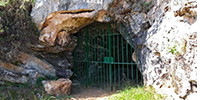 Pasiega Cave in Spain was of mostly academic interest until the discovery that some of the art in the cave may have been put there by Neanderthals. This result has now been discredited. Here is the background to that story, with many drawings of the art of the cave from the old master himself, Breuil.
Pasiega Cave in Spain was of mostly academic interest until the discovery that some of the art in the cave may have been put there by Neanderthals. This result has now been discredited. Here is the background to that story, with many drawings of the art of the cave from the old master himself, Breuil.
Last updated Monday 02 December 2024
 Inconsistencies in the EC books. Amy McDonald has found an inconsistency between the fifth and sixth books concerning Matigan, apprentice to Jondalar.
Inconsistencies in the EC books. Amy McDonald has found an inconsistency between the fifth and sixth books concerning Matigan, apprentice to Jondalar.
Last updated Sunday 04 May 2025
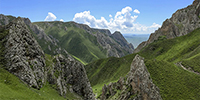 Of all the ancient peoples that have been studied by scientists, none has set puzzles quite so profound as those left behind by the Denisovans. However game changing DNA research and techniques now mean that we can trace which hominins and animals used a particular site. No longer do we need actual fossils to determine this, a small sample of the dirt from the cave or open air site is all that is required. These methods will revolutionise archaeology and anthropology.
Of all the ancient peoples that have been studied by scientists, none has set puzzles quite so profound as those left behind by the Denisovans. However game changing DNA research and techniques now mean that we can trace which hominins and animals used a particular site. No longer do we need actual fossils to determine this, a small sample of the dirt from the cave or open air site is all that is required. These methods will revolutionise archaeology and anthropology.
Last updated Monday 20 December 2021
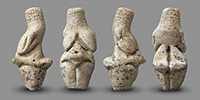 Another Palaeolithic Venus has been discovered in Renancourt, Amiens. The statuette is in good condition, carved in limestone/chalk, and is 40 mm high. It is estimated to be 23 000 years old, and is from the Gravettian. The breasts, buttocks and thighs are all of exaggerated volume, as is normal in this tradition.
Another Palaeolithic Venus has been discovered in Renancourt, Amiens. The statuette is in good condition, carved in limestone/chalk, and is 40 mm high. It is estimated to be 23 000 years old, and is from the Gravettian. The breasts, buttocks and thighs are all of exaggerated volume, as is normal in this tradition.
Last updated Thursday 24 June 2021
 I have reorganised and added to the page on tools, to include sections specifically on the development of the ancient Acheulean hand axe by Homo erectus and the various types of this important tool, and the mastery of its creation by Homo neanderthalensis, who not only made it in the classic fashion, working on a core or nucleus bifacially, known as Moustérien de tradition acheuléenne or MTA, but also took flakes and turned them into bifacially worked Acheulean hand axes. There is a short summary of the development of such tools right through to Neolithic arrow heads, followed by a longer section on the step by step development of the full range of tools from choppers through to the bow and arrow.
I have reorganised and added to the page on tools, to include sections specifically on the development of the ancient Acheulean hand axe by Homo erectus and the various types of this important tool, and the mastery of its creation by Homo neanderthalensis, who not only made it in the classic fashion, working on a core or nucleus bifacially, known as Moustérien de tradition acheuléenne or MTA, but also took flakes and turned them into bifacially worked Acheulean hand axes. There is a short summary of the development of such tools right through to Neolithic arrow heads, followed by a longer section on the step by step development of the full range of tools from choppers through to the bow and arrow.
Last updated Thursday 07 March 2024
 The sites generally known as Atapuerca are a series of very important excavations in the Sierra Atapuerca, in Spain, first discovered as a result of the construction of a railway line through this limestone region. Taken together, the sites are more extensive in terms of hominin discoveries than anywhere else in Europe, or perhaps the world. The discoveries range in age from 1.4 million years old stone tools to neolithic ceramics, and the hominins include Homo erectus, Homo antecessor, Homo heidelbergensis, and Homo neanderthalensis.
The sites generally known as Atapuerca are a series of very important excavations in the Sierra Atapuerca, in Spain, first discovered as a result of the construction of a railway line through this limestone region. Taken together, the sites are more extensive in terms of hominin discoveries than anywhere else in Europe, or perhaps the world. The discoveries range in age from 1.4 million years old stone tools to neolithic ceramics, and the hominins include Homo erectus, Homo antecessor, Homo heidelbergensis, and Homo neanderthalensis.
Last updated Tuesday 08 June 2021
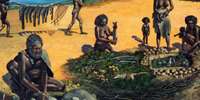
Archaeological / Archeological Sites - Some sites of interest in the study of the Palaeolithic / Paleolithic era.
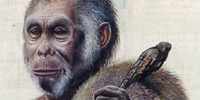
Hominins before Homo sapiens

Venus figures from the Stone Age - The Venus of Willendorf as well as those from or known as: Dolni Vestonice, Galgenberg, Kostenki, Brassempouy, Impudique, Lespugue, Abri Pataud, Monpazier, Tursac, Die Lowenfrau, Savignano, Femme a la Corne, Berekhat Ram, Gagarino and others.
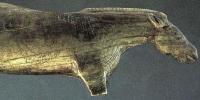
Cave paintings, engravings and sculptures.

Animals, Plants, People and Geology Ice Age Animals, The bear and cavebear in fact, myth and legend, Australian Aboriginal trade routes and fish traps, The Tungus - reindeer herders of the Siberian far north, The Sacred Root, Golden Thread, Frozen Mammoth discovery, Geology for Earth Children fans.
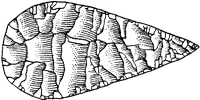
Tools and Decorative Objects of the Stone Age - Tools and other items used in the Stone age, including spear straighteners, firestones, adzes, beads, and needle cases, as well as the physics of a spear thrower and how stone tools are made.

There are a lot of things to learn about photography in museums, the problems are like no other area of photography. Here I try to explain the basics, and the pitfalls involved, and give an indication of what I think is an ideal camera for the situation.

I often need to clean up line drawings of artefacts and sketches - the originals are typically from pdf files, and of poor quality. This method using Photoshop allows me to make much better images than the originals, especially when combined with first making the drawings a lot larger.
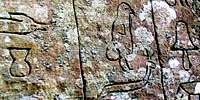
Archeological / Archaeological Forgeries, Hoaxes and Curiosities
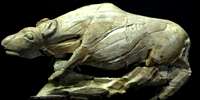
Archeology for Jean Auel fans - the sites and sculptures and places mentioned in Jean Auel's series on life in the ice age.
 Maps of the Earth's Children Series - Maps include the true extent of the ice in the last ice age, as well as maps of The Territory of the Zelandonii, Journeys in Clan of the Cave Bear, local area around the cave in Clan of the Cave Bear, The Valley of Horses, Iron Gates map, local map of the Sharamudoi, local map of The Mammoth Hunters Lion Camp, map of Ukraine, map of The Plains of Passage, Clickable map of the Plains of Passage, Donau Mouth to First Snow from the Plains of Passage, The Encounter with the S'Armunai, Wurm and Riss Glaciation in the headwaters of the Donau (Danube), How I draw the maps.
Maps of the Earth's Children Series - Maps include the true extent of the ice in the last ice age, as well as maps of The Territory of the Zelandonii, Journeys in Clan of the Cave Bear, local area around the cave in Clan of the Cave Bear, The Valley of Horses, Iron Gates map, local map of the Sharamudoi, local map of The Mammoth Hunters Lion Camp, map of Ukraine, map of The Plains of Passage, Clickable map of the Plains of Passage, Donau Mouth to First Snow from the Plains of Passage, The Encounter with the S'Armunai, Wurm and Riss Glaciation in the headwaters of the Donau (Danube), How I draw the maps.

The best frost hardy and drought hardy native plants for Australian gardens including Correas, Grevilleas, Bottlebrush, Banksias, Melaleucas, Mintbushes,
Tea-trees, Eremophilas, Hakeas, Boronias, and lots more. Experts in Waratahs and Flannel Flowers. Licenced to sell Rare and Endangered Flora.
 In 1865, Charles William Hitchcock and his wife Emma (nee Fuller) came out to Australia in the ship 'Royal Dane'. William Henry, my grandfather, was born on the ship on the 24th July 1865 while the ship was anchored in Keppel Bay. This is the index page for a number of family photographs and some of the early family history.
In 1865, Charles William Hitchcock and his wife Emma (nee Fuller) came out to Australia in the ship 'Royal Dane'. William Henry, my grandfather, was born on the ship on the 24th July 1865 while the ship was anchored in Keppel Bay. This is the index page for a number of family photographs and some of the early family history.

A bicycle trip down the Danube from the source of the Danube to Budapest.

Per's Plains of Passage trip from the Donau mouth to its source at Donaueschingen by motorcycle in 1998. Most photos on the clickable map of the Plains of Passage are by courtesy of Per.
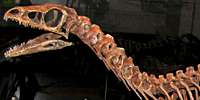
Dinosaurs and other ancient animals. Dinosaurs, or Terrible Lizards, were the dominant terrestrial vertebrates for over 160 million years.
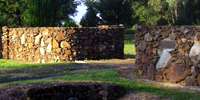
Building good looking stone walls, using concrete foundations, mortar, and formwork, a method even beginners can tackle sucessfully.

Bushwalking - This is an overview of a wonderful part of the world - the gorge country east of Armidale in northern NSW Australia, in which I spend as much time as I can exploring and walking.

Cycling - Cycling for 500 to 700 km over one or two weeks on fully supported rides is a great way to see Australia.
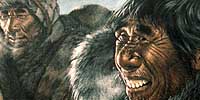
Paintings of ancient times - Giovanni Caselli

An evening with Jean Auel - Various interviews with Jean Auel, talks by her, memories of talks by Jean, inconsistencies in the EC books.

The webmaster on top of Avalanche Peak on a nine week tramping tour of the South Island of New Zealand.
Earth's Children is a registered trademark of Jean M. Auel.
The books in the series: The Clan of the Cave Bear, The Valley of Horses,
The Mammoth Hunters, The Plains of Passage, The Shelters of Stone, and The Land of Painted Caves are all copyrighted by Jean M. Auel.


 A selection of the animals and plants from the Precambrian to the Cretaceous. The page includes maps of the continents of the earth as they travelled back and forth across the globe.
A selection of the animals and plants from the Precambrian to the Cretaceous. The page includes maps of the continents of the earth as they travelled back and forth across the globe.
 The Neo-Assyrian Empire was a powerful state that existed in the ancient Near East from 911 BC to 609 BC. It was the largest empire in the world at the time and covered much of modern-day Iraq, Syria, and parts of Iran, Turkey, and Egypt. The Neo-Assyrians were known for their military might, efficient administration, and innovative use of technology, including the development of siege warfare and the use of iron weapons. They also had a well-organised system of government, with a king who had absolute power and a bureaucracy that helped him govern.
The Neo-Assyrian Empire was a powerful state that existed in the ancient Near East from 911 BC to 609 BC. It was the largest empire in the world at the time and covered much of modern-day Iraq, Syria, and parts of Iran, Turkey, and Egypt. The Neo-Assyrians were known for their military might, efficient administration, and innovative use of technology, including the development of siege warfare and the use of iron weapons. They also had a well-organised system of government, with a king who had absolute power and a bureaucracy that helped him govern.
 Gobustan on the Caspian Sea is a site dated to around 5 000 - 8 000 years BP, where there are paintings or etchings (petroglyphs) of what appear to be long boats in the style of the Viking ships of more recent times, as well as many other types, including human outlines, horses, and aurochs. More photographs and text have been added.
Gobustan on the Caspian Sea is a site dated to around 5 000 - 8 000 years BP, where there are paintings or etchings (petroglyphs) of what appear to be long boats in the style of the Viking ships of more recent times, as well as many other types, including human outlines, horses, and aurochs. More photographs and text have been added.  The oldest cave paintings in Central Europe, estimated at between 23 000 and 35 000 BP, were discovered by a team of Romanian speleologists at the Coliboaia Cave, Romania. More photographs and text have been added.
The oldest cave paintings in Central Europe, estimated at between 23 000 and 35 000 BP, were discovered by a team of Romanian speleologists at the Coliboaia Cave, Romania. More photographs and text have been added.
 The Mladečské Caves are a cave complex in the municipality of Mladeč in the Czech Republic, about 80 km north east of Brno. The site is a valuable resource for artefacts from the Old and Middle Palaeolithic.
The Mladečské Caves are a cave complex in the municipality of Mladeč in the Czech Republic, about 80 km north east of Brno. The site is a valuable resource for artefacts from the Old and Middle Palaeolithic.
 El Pendo Cave, Camargo, province of Santander, is famous for the venus figure found there. More photographs of the cave, the artwork on the walls, and portable art found there have been added.
El Pendo Cave, Camargo, province of Santander, is famous for the venus figure found there. More photographs of the cave, the artwork on the walls, and portable art found there have been added.
 During the Upper Palaeolithic, ice age hunters used the slopes of the Danube valley repeatedly. Willendorf is one such site, and although justly famous for the Venus of Willendorf, it is also an important Gravettian and Aurignacian site for the other artefacts found there.
During the Upper Palaeolithic, ice age hunters used the slopes of the Danube valley repeatedly. Willendorf is one such site, and although justly famous for the Venus of Willendorf, it is also an important Gravettian and Aurignacian site for the other artefacts found there.
 The small cave of Les Eyzies or la Grotte Richard opens above the village of Les Eyzies-de-Tayac, on the right shore of the Beune. Its prehistoric occupation is established in the Upper Magdalenian. It has been largely forgotten, but is an important site.
The small cave of Les Eyzies or la Grotte Richard opens above the village of Les Eyzies-de-Tayac, on the right shore of the Beune. Its prehistoric occupation is established in the Upper Magdalenian. It has been largely forgotten, but is an important site.
 La Madeleine is a rock shelter located in the Vézère valley, in the Dordogne, France. In 1926 the skeleton of a three year old child was discovered, with exquisite shell jewellery, dating from the end of the Magdalenian period. It is a treasure house of art and knowledge about the people of the Magdalenian. Several historic photographs, as well as modern ones of the gisement have been added, as well as much more information on the tools.
La Madeleine is a rock shelter located in the Vézère valley, in the Dordogne, France. In 1926 the skeleton of a three year old child was discovered, with exquisite shell jewellery, dating from the end of the Magdalenian period. It is a treasure house of art and knowledge about the people of the Magdalenian. Several historic photographs, as well as modern ones of the gisement have been added, as well as much more information on the tools. Lalinde/Gonnersdorf figurines and engravings are strictly stylised, overtly female forms with over-sized buttocks, long trunks, small or missing breasts, and no heads. More information and images as well as plans and cross sections of the Gare de Couze and the Grotte de la Roche near the town of Lalinde have been added.
Lalinde/Gonnersdorf figurines and engravings are strictly stylised, overtly female forms with over-sized buttocks, long trunks, small or missing breasts, and no heads. More information and images as well as plans and cross sections of the Gare de Couze and the Grotte de la Roche near the town of Lalinde have been added.
 Micoque tools - La Micoque is a Neanderthal site in the Dordogne dating from circa 400 000 BP to 130 000 BP. A number of tools have been added to the page.
Micoque tools - La Micoque is a Neanderthal site in the Dordogne dating from circa 400 000 BP to 130 000 BP. A number of tools have been added to the page.
 Le Moustier is the type site for the Mousterian suite of tools and artefacts, and is a Neanderthal site. It is of interest primarily to those specialising in le Moustier and the lithic industry of the Mousterian. Several tools from Le Moustier have been added to this page.
Le Moustier is the type site for the Mousterian suite of tools and artefacts, and is a Neanderthal site. It is of interest primarily to those specialising in le Moustier and the lithic industry of the Mousterian. Several tools from Le Moustier have been added to this page.
 Fontalès is a rock shelter and prehistoric site of the Magdalenian, which is in the commune of Saint-Antonin-Noble-Val , in Tarn-et-Garonne. It was excavated in 1865 by Victor Brun, then from 1936 to 1960 by Paul Darasse. The site has yielded a stratigraphic sequence comprising several levels of occupation dating from the Upper Magdalenian.
Fontalès is a rock shelter and prehistoric site of the Magdalenian, which is in the commune of Saint-Antonin-Noble-Val , in Tarn-et-Garonne. It was excavated in 1865 by Victor Brun, then from 1936 to 1960 by Paul Darasse. The site has yielded a stratigraphic sequence comprising several levels of occupation dating from the Upper Magdalenian.
 La Grande Grotte de Saint-Front is a little over a kilometre upstream from Domme, on the left bank of the Dordogne. Also known as La Grotte du Mammouth, it contains a number of engravings and sculptures, including a superb Mammoth on a high ceiling.
La Grande Grotte de Saint-Front is a little over a kilometre upstream from Domme, on the left bank of the Dordogne. Also known as La Grotte du Mammouth, it contains a number of engravings and sculptures, including a superb Mammoth on a high ceiling.
 In Morocco, archaeologists have discovered what they claim to be the oldest jewellery ever found in the world. They are perforated shells that are up to 150 000 years old. The shells, which were believed to have been made into necklaces and bracelets, were found in the Bizmoune Cave near the coastal town of Essaouira.
In Morocco, archaeologists have discovered what they claim to be the oldest jewellery ever found in the world. They are perforated shells that are up to 150 000 years old. The shells, which were believed to have been made into necklaces and bracelets, were found in the Bizmoune Cave near the coastal town of Essaouira.
 An account of the Battle of Megiddo (fought in the 15th century BC) between Egyptian forces under the command of Pharaoh Thutmose III and a large rebellious coalition of Canaanite vassal states led by the king of Kadesh. It is the first battle to have been recorded in what is accepted as relatively reliable detail.
An account of the Battle of Megiddo (fought in the 15th century BC) between Egyptian forces under the command of Pharaoh Thutmose III and a large rebellious coalition of Canaanite vassal states led by the king of Kadesh. It is the first battle to have been recorded in what is accepted as relatively reliable detail.
 In 1940 at Baume-Latrone, or Latrone Cave, drawings from the Upper Palaeolithic were discovered in a deep network 240 metres from the entrance.
They have a unique style, and have been assigned to the Aurignacian. They have been dated to 37 464 BP (cal).
In 1940 at Baume-Latrone, or Latrone Cave, drawings from the Upper Palaeolithic were discovered in a deep network 240 metres from the entrance.
They have a unique style, and have been assigned to the Aurignacian. They have been dated to 37 464 BP (cal).
 Pasiega Cave in Spain was of mostly academic interest until the discovery that some of the art in the cave may have been put there by Neanderthals. This result has now been discredited. Here is the background to that story, with many drawings of the art of the cave from the old master himself, Breuil.
Pasiega Cave in Spain was of mostly academic interest until the discovery that some of the art in the cave may have been put there by Neanderthals. This result has now been discredited. Here is the background to that story, with many drawings of the art of the cave from the old master himself, Breuil.
 Inconsistencies in the EC books. Amy McDonald has found an inconsistency between the fifth and sixth books concerning Matigan, apprentice to Jondalar.
Inconsistencies in the EC books. Amy McDonald has found an inconsistency between the fifth and sixth books concerning Matigan, apprentice to Jondalar.  Another Palaeolithic Venus has been discovered in Renancourt, Amiens. The statuette is in good condition, carved in limestone/chalk, and is 40 mm high. It is estimated to be 23 000 years old, and is from the Gravettian. The breasts, buttocks and thighs are all of exaggerated volume, as is normal in this tradition.
Another Palaeolithic Venus has been discovered in Renancourt, Amiens. The statuette is in good condition, carved in limestone/chalk, and is 40 mm high. It is estimated to be 23 000 years old, and is from the Gravettian. The breasts, buttocks and thighs are all of exaggerated volume, as is normal in this tradition.





 This sitemap link provides access to all the pages on my site.
This sitemap link provides access to all the pages on my site.  Maps of the Earth's Children Series including a map of Journeys in the Land of Painted Caves, the last book in the series.
Maps of the Earth's Children Series including a map of Journeys in the Land of Painted Caves, the last book in the series.  Birdstones are small, abstract stone carvings that resemble a bird and are thought to have been used as a weight for an atlatl. They are generally three to four inches long and less than two inches tall. They are found at archaic sites in midwestern and eastern North America, including the Great Lakes region and east of the Mississippi River. The majority are made from banded slate, particularly the greenish-grey Huronian variety, but other stones like porphyry have also been used.
Birdstones are small, abstract stone carvings that resemble a bird and are thought to have been used as a weight for an atlatl. They are generally three to four inches long and less than two inches tall. They are found at archaic sites in midwestern and eastern North America, including the Great Lakes region and east of the Mississippi River. The majority are made from banded slate, particularly the greenish-grey Huronian variety, but other stones like porphyry have also been used.
 Accessing the collection of rock art photographs by Heinrich Wendel, who documented many of the rock art sites in the Franco-Cantabrian region between 1964 and 1970 - the Neanderthal Museum has kindly made available to the general public the collection of superb photographs from the Wendel Collection. This page will show you how to access the page and to download any files you wish to use.
Accessing the collection of rock art photographs by Heinrich Wendel, who documented many of the rock art sites in the Franco-Cantabrian region between 1964 and 1970 - the Neanderthal Museum has kindly made available to the general public the collection of superb photographs from the Wendel Collection. This page will show you how to access the page and to download any files you wish to use.  Dots and lines are the most ubiquitous abstract symbols in Palaeolithic art, whether on the walls of caves or on suitable pieces of bone and ivory. Many researchers have noted the occurrence of these symbols, and their occurrence particularly in relation to representations of animals. Here I have put together some of the best examples. The evidence presented here shows that where the evidence exists and the data is sufficient, there is no correlation between the Taxon and the number of dots or lines. For example, horses have numbers of dots and lines which are spread across the range of 1, 2, 3, 4, 5, 6, and 7, and Aurochs (early cattle) have numbers of dots and lines which include 1, 3, 4, 5, 6, 18, and many.
Dots and lines are the most ubiquitous abstract symbols in Palaeolithic art, whether on the walls of caves or on suitable pieces of bone and ivory. Many researchers have noted the occurrence of these symbols, and their occurrence particularly in relation to representations of animals. Here I have put together some of the best examples. The evidence presented here shows that where the evidence exists and the data is sufficient, there is no correlation between the Taxon and the number of dots or lines. For example, horses have numbers of dots and lines which are spread across the range of 1, 2, 3, 4, 5, 6, and 7, and Aurochs (early cattle) have numbers of dots and lines which include 1, 3, 4, 5, 6, 18, and many.
 Ancient Egyptian culture from its beginnings through the dynasties to the Ptolemaic period and its eventual decline as a Roman Province, told through reference to its mummies, statues, burial practices and artefacts.
Although my first love is the stone age, mostly before 10 000 BP, I have also become interested in the magnificent works of art produced in ancient Egypt. This set of pages is being constantly updated.
Ancient Egyptian culture from its beginnings through the dynasties to the Ptolemaic period and its eventual decline as a Roman Province, told through reference to its mummies, statues, burial practices and artefacts.
Although my first love is the stone age, mostly before 10 000 BP, I have also become interested in the magnificent works of art produced in ancient Egypt. This set of pages is being constantly updated.
 The Gudenushöhle cave is situated 20 km northwest of the city of Krems, in the valley of the Little Krems, not far from Willendorf, in Lower Austria. The site is close to the River Danube, and has yielded both Neanderthal and Magdalenian artefacts, including many tools, as well as an engraved reindeer bone and a fragment of a bone flute dated to about 18 000 – 12 000 BP.
The Gudenushöhle cave is situated 20 km northwest of the city of Krems, in the valley of the Little Krems, not far from Willendorf, in Lower Austria. The site is close to the River Danube, and has yielded both Neanderthal and Magdalenian artefacts, including many tools, as well as an engraved reindeer bone and a fragment of a bone flute dated to about 18 000 – 12 000 BP.
 Altamira Cave is 270 metres long and consists of a series of twisting passages and chambers, and is decorated with ice age paintings. The artists used charcoal and ochre or haematite to create the images. They also exploited the natural contours in the cave walls to give their subjects a three-dimensional effect. The Polychrome Ceiling is the most impressive feature of the cave, depicting a herd of extinct Steppe Bison in different poses, two horses, a large doe, and possibly a wild boar. Around 13 000 years ago a rockfall sealed the cave's entrance, preserving its contents until its eventual discovery.
Altamira Cave is 270 metres long and consists of a series of twisting passages and chambers, and is decorated with ice age paintings. The artists used charcoal and ochre or haematite to create the images. They also exploited the natural contours in the cave walls to give their subjects a three-dimensional effect. The Polychrome Ceiling is the most impressive feature of the cave, depicting a herd of extinct Steppe Bison in different poses, two horses, a large doe, and possibly a wild boar. Around 13 000 years ago a rockfall sealed the cave's entrance, preserving its contents until its eventual discovery.
 Photoshop for beginners - I am not an expert, I am a beginner myself (though I have spent many years trying to understand a small part of this encyclopaedia for image manipulation), but this text and images may be of use to someone just starting out on the Photoshop journey. At the moment it covers part of rotation and cropping and healing of images, removing backgrounds, and healing just the edge of an object. I will be adding to this initial study as time affords.
Photoshop for beginners - I am not an expert, I am a beginner myself (though I have spent many years trying to understand a small part of this encyclopaedia for image manipulation), but this text and images may be of use to someone just starting out on the Photoshop journey. At the moment it covers part of rotation and cropping and healing of images, removing backgrounds, and healing just the edge of an object. I will be adding to this initial study as time affords.
 The swamp ape Oreopithecus bambolii was 120 cm tall and weighed 30 kg, with a brain capacity of up to 200 cm3 lived in swampy areas of what is now Italy, 10 to 8 million years ago. The long forelimbs are indicative of tree-dwelling. The ape went extinct after a land bridge connected their island to the mainland, allowing large saber-toothed cats and other predators to stalk the island.
The swamp ape Oreopithecus bambolii was 120 cm tall and weighed 30 kg, with a brain capacity of up to 200 cm3 lived in swampy areas of what is now Italy, 10 to 8 million years ago. The long forelimbs are indicative of tree-dwelling. The ape went extinct after a land bridge connected their island to the mainland, allowing large saber-toothed cats and other predators to stalk the island.
 Achenheim is an important site from the Middle Palaeolithic (75 000 to 35 000 years ago) and bears witness to the presence of Neanderthal man in Alsace: Achenheim was an animal butchering area. The site includes the bones of several large animals (rhinoceros, horse, mammoth, bison, Megaloceros) butchered on the spot after the hunt.
Achenheim is an important site from the Middle Palaeolithic (75 000 to 35 000 years ago) and bears witness to the presence of Neanderthal man in Alsace: Achenheim was an animal butchering area. The site includes the bones of several large animals (rhinoceros, horse, mammoth, bison, Megaloceros) butchered on the spot after the hunt.
 Magical amber animals - many of the Mesolithic period’s artistic masterpieces have been found in Denmark. Among them are bears, a bird and an elk of amber. The figures are elegant and shaped in a way that is true to nature. The people who made them must have had a good knowledge of how a real bear, and other animals, looked. Like many other amber finds from the Stone Age, the animal figures have been found in bogs or on beaches. Many appear to be amulets, and probably had great spiritual significance.
Magical amber animals - many of the Mesolithic period’s artistic masterpieces have been found in Denmark. Among them are bears, a bird and an elk of amber. The figures are elegant and shaped in a way that is true to nature. The people who made them must have had a good knowledge of how a real bear, and other animals, looked. Like many other amber finds from the Stone Age, the animal figures have been found in bogs or on beaches. Many appear to be amulets, and probably had great spiritual significance.
 The Venus of Willendorf is made of a rock called oolite, a form of limestone that is not found in or around Willendorf. Gerhard Weber and his team from the University of Vienna have now found out with the help of high-resolution tomographic images that the material from which the Venus was carved likely comes from northern Italy, at Lake Garda, about 700 km away.
The Venus of Willendorf is made of a rock called oolite, a form of limestone that is not found in or around Willendorf. Gerhard Weber and his team from the University of Vienna have now found out with the help of high-resolution tomographic images that the material from which the Venus was carved likely comes from northern Italy, at Lake Garda, about 700 km away.
 Iron smelting was unknown in Egypt 3 400 years ago, yet a dagger from the tomb of Pharaoh Tutankhamun has been positively identified as having an iron blade made from metal extracted from a meteorite. It may have been a gift from Tušratta, king of Mitanni to Pharaoh Amenhotep III, who passed it on to his son, Akhenaten, who in turn passed it on to Tutankhamun.
Iron smelting was unknown in Egypt 3 400 years ago, yet a dagger from the tomb of Pharaoh Tutankhamun has been positively identified as having an iron blade made from metal extracted from a meteorite. It may have been a gift from Tušratta, king of Mitanni to Pharaoh Amenhotep III, who passed it on to his son, Akhenaten, who in turn passed it on to Tutankhamun.
 La Quina is a Neanderthal site located in the Charente region of south-western France. The artisans of the La Quina Mousterian industry type (thick asymmetric tools transformed many times) had a particular way of life: they were hunters specialising in the hunt for Reindeer or Bison, and they moved following the herds. Several tools from La Quina have been added to this page.
La Quina is a Neanderthal site located in the Charente region of south-western France. The artisans of the La Quina Mousterian industry type (thick asymmetric tools transformed many times) had a particular way of life: they were hunters specialising in the hunt for Reindeer or Bison, and they moved following the herds. Several tools from La Quina have been added to this page.

 In the Pacific Northwest Coast mythology, Raven is the powerful figure who transforms the world. Stories tell how Raven created the land, released the people from a cockle shell, and brought them fire. Raven stole the light and brought it out to light up the world. Yet Raven is a trickster—often selfish, hungry, and mischievous. He changes the world only by cleverly deceiving others in his never - ending quest for food.
In the Pacific Northwest Coast mythology, Raven is the powerful figure who transforms the world. Stories tell how Raven created the land, released the people from a cockle shell, and brought them fire. Raven stole the light and brought it out to light up the world. Yet Raven is a trickster—often selfish, hungry, and mischievous. He changes the world only by cleverly deceiving others in his never - ending quest for food.
 The Ishtar Gate was the eighth gate to the inner city of Babylon. It was constructed in about 575 BC by order of King Nebuchadnezzar II on the north side of the city. It was part of a grand walled processional way leading into the city. The walls were finished in glazed bricks mostly in blue, with animals and 'dragons' in low relief at intervals, these also made up of bricks that are moulded and coloured differently.
The Ishtar Gate was the eighth gate to the inner city of Babylon. It was constructed in about 575 BC by order of King Nebuchadnezzar II on the north side of the city. It was part of a grand walled processional way leading into the city. The walls were finished in glazed bricks mostly in blue, with animals and 'dragons' in low relief at intervals, these also made up of bricks that are moulded and coloured differently.
 On the banks of the Bengawan Solo River in Java, Indonesia, 19th-century physician Eugène Dubois uncovered an astounding fossil find: the bones of what appeared to be an ancient human, surrounded by animal remains and shells. Excavated in the 1890s, the site gained fame as the home of 'Java Man', better known today as Homo erectus. Deliberate scratching on a fossil Pseudodon shell, is almost certainly an engraving made by Homo erectus at Trinil in Indonesia.
On the banks of the Bengawan Solo River in Java, Indonesia, 19th-century physician Eugène Dubois uncovered an astounding fossil find: the bones of what appeared to be an ancient human, surrounded by animal remains and shells. Excavated in the 1890s, the site gained fame as the home of 'Java Man', better known today as Homo erectus. Deliberate scratching on a fossil Pseudodon shell, is almost certainly an engraving made by Homo erectus at Trinil in Indonesia.
 Of all the ancient peoples that have been studied by scientists, none has set puzzles quite so profound as those left behind by the Denisovans. However game changing DNA research and techniques now mean that we can trace which hominins and animals used a particular site. No longer do we need actual fossils to determine this, a small sample of the dirt from the cave or open air site is all that is required. These methods will revolutionise archaeology and anthropology.
Of all the ancient peoples that have been studied by scientists, none has set puzzles quite so profound as those left behind by the Denisovans. However game changing DNA research and techniques now mean that we can trace which hominins and animals used a particular site. No longer do we need actual fossils to determine this, a small sample of the dirt from the cave or open air site is all that is required. These methods will revolutionise archaeology and anthropology.
 I have reorganised and added to the page on tools, to include sections specifically on the development of the ancient Acheulean hand axe by Homo erectus and the various types of this important tool, and the mastery of its creation by Homo neanderthalensis, who not only made it in the classic fashion, working on a core or nucleus bifacially, known as Moustérien de tradition acheuléenne or MTA, but also took flakes and turned them into bifacially worked Acheulean hand axes. There is a short summary of the development of such tools right through to Neolithic arrow heads, followed by a longer section on the step by step development of the full range of tools from choppers through to the bow and arrow.
I have reorganised and added to the page on tools, to include sections specifically on the development of the ancient Acheulean hand axe by Homo erectus and the various types of this important tool, and the mastery of its creation by Homo neanderthalensis, who not only made it in the classic fashion, working on a core or nucleus bifacially, known as Moustérien de tradition acheuléenne or MTA, but also took flakes and turned them into bifacially worked Acheulean hand axes. There is a short summary of the development of such tools right through to Neolithic arrow heads, followed by a longer section on the step by step development of the full range of tools from choppers through to the bow and arrow.
 The sites generally known as Atapuerca are a series of very important excavations in the Sierra Atapuerca, in Spain, first discovered as a result of the construction of a railway line through this limestone region. Taken together, the sites are more extensive in terms of hominin discoveries than anywhere else in Europe, or perhaps the world. The discoveries range in age from 1.4 million years old stone tools to neolithic ceramics, and the hominins include Homo erectus, Homo antecessor, Homo heidelbergensis, and Homo neanderthalensis.
The sites generally known as Atapuerca are a series of very important excavations in the Sierra Atapuerca, in Spain, first discovered as a result of the construction of a railway line through this limestone region. Taken together, the sites are more extensive in terms of hominin discoveries than anywhere else in Europe, or perhaps the world. The discoveries range in age from 1.4 million years old stone tools to neolithic ceramics, and the hominins include Homo erectus, Homo antecessor, Homo heidelbergensis, and Homo neanderthalensis.








 In 1865, Charles William Hitchcock and his wife Emma (nee Fuller) came out to Australia in the ship 'Royal Dane'. William Henry, my grandfather, was born on the ship on the 24th July 1865 while the ship was anchored in Keppel Bay. This is the index page for a number of family photographs and some of the early family history.
In 1865, Charles William Hitchcock and his wife Emma (nee Fuller) came out to Australia in the ship 'Royal Dane'. William Henry, my grandfather, was born on the ship on the 24th July 1865 while the ship was anchored in Keppel Bay. This is the index page for a number of family photographs and some of the early family history.





